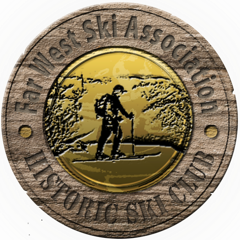by Tom Ryugo, NSC Member
We skied at Sugar Bowl on Saturday. There’s a ridiculous amount of snow there as you can see from the snow pile next to the Sugar Bowl parking lot.
Way back in 2007, after Nelson helped us paint the interior of the house we had just bought, I said payment could be a lesson on how to ski moguls. Well, Saturday I finally manage to pay it off – plus I gave Derek a lesson on mogul skiing as well.
Nelson and Derek did very well skiing the bumps especially considering Derek was skiing for the fourth time and had never done moguls before. They both had the usual beginner issues – letting the steepness of the slope intimidate them, leading to them both leaning back too much instead of weight forward and facing down the slope.
In any case, afterwards, I got to thinking about why many people have difficulty skiing on moguls while others make it look effortless. I think it was Ed who said moguls were no fun because “you get to the bottom of the hill exhausted and drenched in sweat. Well, I realized that now I can ski an entire mogul run without even breaking a sweat. Why might that be?
Almost 30 years ago, I got a mogul lesson from fellow Nisei Ski Club member Ron Kaida. Those who know Ron know that he was one of NSC’s best mogul skiers – he looked like he could balance a jar on his shoulder while skiing a double black diamond run. Ron looked at how I skied and said “You’re trying to outmuscle the mountain. Let the skis do the work.” He said that if you put the skis on their edges, the skis will turn. So when you hit the top of the mogul, tilt the skis on their edges and carve a turn around the backside of the mogul.
If you watch an expert mogul skier, you’ll see that they keep their knees and feet close together. Why?
It all starts with the shape of the ski. The ski tip is obviously curved. So when you tilt the ski on its edge, the ski will turn. It turns left on the left edge and right on the right edge. The more you tilt the ski, the sharper the turn it makes. When the edge carves a turn, it creates friction that slows the ski. The sharper the turn, the greater the friction and the more it slows the ski.
On the other hand, if the ski is flat on the snow, it doesn’t turn at all. Additionally, if the ski is flat on the snow, there’s no friction so the ski will pick up speed. If you lean back, the tails will be flat on the ground, the tip won’t turn the ski, and the ski will go straight while picking up speed – and you can’t control the ski.
If you keep the skis close together, both skis will tilt almost equally and therefore both skis carve the turns and scrub the speed in the process. Since both skis are doing the work of turning and scrubbing speed, it means you use less energy.
Beginners let the slope intimidate them. They think they’re going too fast when they’re really not moving that fast – the steepness causes that perception. They also don’t keep their head and shoulders facing down the hill which would help keep them from leaning back. They also have a tendency to let their arms fall behind them instead of keeping both arms in front of them.
You can practice good form on a groomed blue run before trying it on a mogul run.
- Keep your knees together.
- Bend your knees at the start of the turn and straighten up during the turn.
- Reach downhill to plant the pole.
- Tilt the skis on their edges and carve the turn.
- Once the turn is complete, pivot to the other edges and carve a turn the other direction.
- Here are some pics from Sugar Bowl








